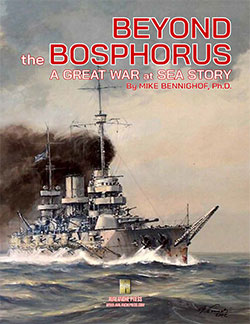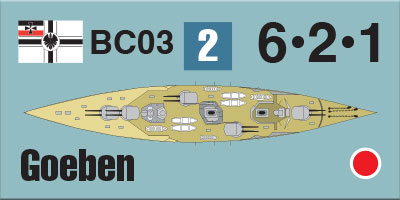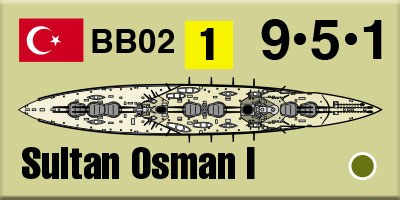| Beyond the Bosphorus:
Publisher’s Preview
By Mike Bennighof, Ph.D.
March 2024
 This is where it all began. I’d designed a small game based on World War One naval operations on the Black Sea; my friend and mentor Jack Greene wanted to use it as an operational framework for one of his tactical naval games. “You should do something more with that game where you move fleets on the map,” my then-girlfriend told me. “Publish it, maybe make some more like it.” This is where it all began. I’d designed a small game based on World War One naval operations on the Black Sea; my friend and mentor Jack Greene wanted to use it as an operational framework for one of his tactical naval games. “You should do something more with that game where you move fleets on the map,” my then-girlfriend told me. “Publish it, maybe make some more like it.”
And so, I married the girlfriend and eventually became a wargame publisher.
Beyond the Bosphorus takes up the theme of that little game that gave birth to the Great War at Sea series: the further adventures of the German battle cruiser Goeben on the Black Sea, fighting the Russian Black Sea Fleet. It’s a complete game, with its own little map (the Black Sea is very small, relatively speaking) and pieces and rulebook.
After many years publishing wargames, it’s finally come to me that, at least part of the time, I need to be publishing the games I really want to design, write, and publish.
We included the Black Sea in previous Great War at Sea games set in the Mediterranean, but there it was a sideshow. It’s the centerpiece of Beyond the Bosphorus, and that’s an opportunity to craft the closely-focused story that I like designing and writing. And since the entire game system was originally designed for the Black Sea campaign, it works particularly well there.
The naval campaign on the Black Sea is one of the lesser-known events of the First World War, much less of all military history, and I suppose it’s fitting that I started game design with a game set there. I’ve lately moved away from such obscure topics, but the scenario set with its historical story arc is just too good to pass up. I’d originally intended to include the campaign in Great War at Sea: The Wine Dark Sea, but realized that I’d regret not giving it its own separate book.

The Black Sea is a self-contained theater. The Turks and Germans are down at the lower left corner with a base at Constantinople; they have a few minor ports on the Anatolian coast but nowhere else to re-arm, re-fuel or seek repairs. The Russians are right across the water at Sevastopol, a heavily fortified base in a central location dominating the Black Sea basin, with some large commercial ports also at their disposal like Odessa and Novorossisk.
The Turkish fleet is pretty much worthless, with only a pair of protected cruisers, two torpedo gunboats and four German-built destroyers having any fighting value. They also have two elderly pre-pre-dreadnought battleships with the speed of a trash barge, a reconditioned ironclad and a handful of small torpedo boats.
It’s the two German ships that give the Central Powers the ability to wage war at sea: the famous battle cruiser Goeben and the light cruiser Breslau. Goeben’s builders, Blohm & Voss of Hamburg, stuck the Imperial Navy with a lemon, a ship always in need of some sort of machinery repair. But when she’s mission-capable, the Russians have nothing to match her speed and until their dreadnoughts finally come into service, nothing to match her protection and firepower. Likewise, they have no cruisers capable of pacing Breslau, though like other German light cruisers of the war’s first years she’s lacking in firepower for her size.
In the war’s first year, the Russian Black Sea Fleet relies on a squadron of five pre-dreadnought battleships. They’re slow, and the two oldest are positively ancient mariners that should have been retired before the war’s beginning. But their gunnery is excellent, and the Russians have developed very effective gunnery control from the squadron flagship rather than each ship firing on its own.

Over the next year, the Russians pick up two dreadnought battleships, though they lose one to an internal explosion almost exactly one year later. That changes the dynamics, as the Russians now have individual ships able to sink Goeben on their own. A third such ship appears in 1917, but by then the naval campaign on the Black Sea was essentially over.
It wouldn’t be an Avalanche Press naval game without a few ships that never actually made it to sea, at least not under their original flags. The Turks can play with their “stolen dreadnoughts,” the pair of battleships built in Britain and commandeered by the Royal Navy before the Ottoman fleet could take delivery. Plus, they have the pair of scout cruisers ordered in Britain and never completed. Together with the six modern destroyers ordered in France and never built, they have the core of a modern, powerful surface fleet to challenge the Russians.
For their part, the Russians have that third dreadnought that never made it into action, and the fourth improved dreadnought that would never be completed. Together with the four big, fast light cruisers of the “Admiral” class and the many Novik-type destroyers, they too have the makings of a modern, powerful surface fleet to fend off the Turkish-German challenge.

Beyond the Bosphorus follows the pattern of other Second Edition Great War at Sea games, with historical text interwoven with the scenarios so they tell the story of the campaign. While the Black Sea appeared in our old Mediterranean game, compared to that set we have many more battle scenarios. In our story-arc format, each operational scenario (the ones where fleet seek each other on the Black Sea map) is accompanied by at least one battle scenario (the ones resolved on the Naval Tactical Map, where ships fight each other with guns and torpedoes), that arose or could have arisen from the operation. We also have to make sure that all of the pieces in the game see action on the map, including those never-completed/purchased ships like Imperator Nikolai I or Sultan Osman I.
Beyond the Bosphorus is the introductory game for Great War at Sea’s Second Edition. It’s perfectly suited to the task; after all, this is the theater the system was designed to re-create. After 30 years of Avalanche Press, it’s clear to me that this is the last time I’ll revisit this topic. There won’t be a chance to do it over and get it right that time. This is our best and final shot, and it’s the game I want to publish. As such, it’s receiving the very best we have to offer.
Click here to join the Gold Club.
See your Gold Club Insider newsletter for ordering information.
Sign up for our newsletter right here. Your info will never be sold or transferred; we'll just use it to update you on new games and new offers.
Mike Bennighof is president of Avalanche Press and holds a doctorate in history from Emory University. A Fulbright Scholar and NASA Journalist in Space finalist, he has published a great many books, games and articles on historical subjects; people are saying that some of them are actually good.
He lives in Birmingham, Alabama with his wife, three children, and his new puppy. His Iron Dog, Leopold, could swim very well.
Want to keep Daily Content free of third-party ads? You can send us some love (and cash) through this link right here.
|
